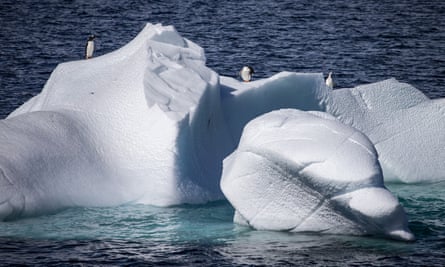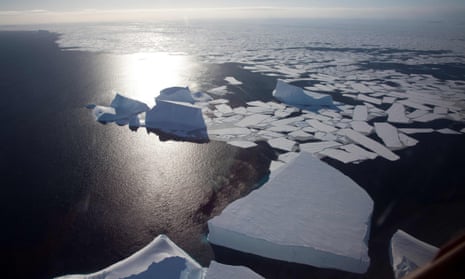Most mornings since the end of March and before Will Hobbs has done much at all other than make a coffee, he scrolls his inbox looking for one particular email.
Generated and sent automatically from a colleague, the email arrives just after 4am and gives the latest data from a US government satellite showing how much sea ice is floating around Antarctica.
“Unprecedented is a word that gets bandied around a lot, but it doesn’t really get to just how shocking this is,” says Hobbs, a sea ice scientist at the University of Tasmania.
“It is very much outside our understanding of this system.”
In February, the floating sea ice around Antarctica hit a record low for the second year running. Since satellites started tracking the region’s ice in 1979, there had never been less ice.
As it does every year, as the temperatures around the continent plunged towards winter, the sea ice started to return.
But the moderate alarm from scientists at that record low – coming only a year after a previous record low – is now being overlaid with astonishment. Some are worried they could be witnessing the start of a slow collapse of Antarctica’s sea ice.
By now there would usually be about 16.4m square kilometres of Antarctic sea ice. But this week, there was just 14.1m sq km. An area bigger than Mexico has failed to freeze.
“There’s a sense that something weird is going on. It’s dropping way below anything we have seen in our record,” says Dr Walt Meier, a senior scientist at the National Snow and Ice Data Centre (NSIDC) at the University of Colorado.
Meier’s job is to help collate and present data from US satellites that have been recording sea ice since November 1978.
It’s the same data that gets presented in Hobbs’ daily email and the same data that has been turned into charts and spread on social media around the world in recent weeks.
The current sea ice anomaly remains more than 2 million square kilometers below the 1981-2010 average for this time of year (https://t.co/V0Lt0w1sTi). pic.twitter.com/Q2zIgogCIm
— Zack Labe (@ZLabe) July 23, 2023
Every day a defence satellite passes over the region with an instrument onboard which – through clouds and at night – can detect whether the ocean surface is covered by ice or water.
Every morning about 7am in Boulder, Colorado, an automated system pulls the data, runs an algorithm and spits out how much ice has been around the continent, averaged over the past five days.
“In terms of it being relative to normal, we are even further behind where we were in February,” Meier says. “It’s quite remarkable and there are moments we look and say: wow, this is strange.”
Not only is there less ice, but the reduction is being seen almost all the way around the continent’s 18,000km coastline.
Why the crash?
While the floating ice in the northern Arctic has behaved as scientists and climate models expected in a warming world – that is, on an apparent terminal decline – Antarctica’s sea ice has held steady.
But in 2016, something flipped. Only two years after a record high, 2016 delivered a record low, and there’s been a strong downward trend ever since. Scientists are still debating why.
A big part of the challenge in understanding Antarctica’s sea ice is its location. Surrounded by vast ocean on all sides, the sea ice is affected by winds, storms, air temperature, changes in ocean heat, saltiness and how different layers of ocean mix. Unpicking all those influences and interactions to uncover any climate change influence is tricky.
after newsletter promotion
Meier says it is hard to know if the changes are natural or human caused – or a mix of both – and says there is some evidence of a similar sudden swing from high levels of sea ice to very low in photographs from mid-1960s satellites.
Dr Andrew Meijers, an oceanographer at the British Antarctic Survey, says many climate scientists who were “not necessarily sea ice folk” suspect the drops since 2016 showed climate change had “finally burned through the natural barriers around the sea ice formed by the unique wind and atmospheric circulation”. But there was a lack of concrete evidence to support that view.
“Overall, the feeling is something big is happening this year, and this is probably associated with the wider decline since 2016,” says Meijers. “Whether this is anthropogenically driven, and if so, what the driver may be, is still up for debate.”
But there is at least one working theory for the loss of sea ice. The waters all around Antarctica are oddly topsy-turvy. The upper levels of the ocean are stratified – a cooler and less salty layer on top and a warmer and denser layer from about 150-300 metres.
Prof Alex Haumann, an oceanographer and sea ice expert at Alfred Wegener Institute in Munich, says there’s evidence that just before the current declines, the top layer became saltier and mixed with the lower layer, allowing the warmer water to reach the surface and make it harder for ice to form.
This could be linked to natural weather patterns, but he says what’s not explainable is that the warm layer has been getting “considerably warmer” since the 1960s.
Haumann, who has presented his theory to colleagues at several regional and international meetings, says that given his theory, this year’s extraordinary drops were not unexpected.
“People have been betting me beers that this [theory] was wrong,” he says. “It’s a safe bet for me.”
High stakes
Losing Antarctica’s sea ice would have major knock-on effects – not just for the krill, fish, penguins, seals and other animals that rely on it.
Melting sea ice doesn’t itself raise sea levels because it’s already floating. But Dr Ariaan Purich, a climate scientist at Monash University and an expert on the continent’s sea ice, lists three reasons to be concerned.
Loss of ice means less of the sun’s energy is reflected back to space, causing more warming of the ocean. Antarctic sea ice also influences the way the ocean circulates oxygen and nutrients around the globe.

But the sea ice also protects the ice attached to the land by buffering waves, and this is what many scientists find the most troubling.
“Without it, the waves break on the ice shelves and cause them to break away faster. Then the ice sheet could slide into the ocean faster, raising sea levels globally,” says Purich.
“I think everyone’s asking what’s happening right now. It’s unbelievable. There’s this worry about what kind of world we’re coming in to.
“Given the evidence, I feel like it would be irresponsible not to be linking it to global warming, with a warmer atmosphere and a warmer ocean.”
All the scientists Guardian Australia spoke to said there was a desperate need for more research and funding to help them to provide answers.
“I’m genuinely worried,” says Hobbs. “As a scientist I’m worried that I can’t find the answers, or that we might have missed something. And it feels like the stakes are very high in getting this wrong.
“If – and it’s a big if – this is a functional collapse of the system, that means we need to reappraise our sea level projections, and that affects a lot of people. These are the stakes we are playing for. As scientists we have a real responsibility not to mess this up.”
